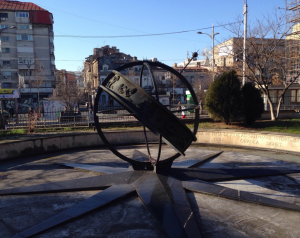Written by Dennys Cifuentes
Sunday, January 7, 2018 – Day 2
Today, we took a trip to the city of Bucharest, which is the capital of Romania. In this trip, we took a tour of the Palace of Parliament. Some interesting facts about the palace is that it is the third biggest parliament in the world, with the first being in Florida and the second in Mexico. In addition, it contains 2,800 chandeliers and 1,000 rooms. It was estimated that the Palace was worth $1.7 Billion in the 1980s. The palace’s architect was Nicolae Ceausescu. He ventilated the palace using series of consecutive slits and holes through which fresh air is allowed to enter from the outside into the palace. In terms of heating, material such as brass and oak were used for heat covers.
After the tour of the Palace, we headed out to the streets of Bucharest where we saw unique architecture from building to building – mostly Neo-Classical style. From the busses to the subways, we experienced how busy it can get in Bucharest – it was quite similar to New York City. We even saw the oldest hospital in Bucharest, which was built in 1704. Another interesting site we saw was Kilometer 0. It’s a compass-like structure showing exactly where the center of the country is located with directions to the country’s main cities. However, geographically Bucharest is located south east of Romania and not in the center, but all roads are measured from this point.
Soon after exploring the city of Bucharest, we went to the Village Museum. The museum displayed a replica of a village in Transylvania from the 1700s. Most of the homes in the village were made of wood, specifically mahogany and oak. Most of the house in the replica are real houses that were moved from their original location to the museum. The homes usually had a center room which included a bed as well as a table and chest. Sometimes the center room was used for weddings, funerals, and other special events. The social classes were clearly shown in the village based on the size of the gate or fence in front of the house. The bigger the gate, the higher the family’s socioeconomic class. The village also had a Russian house which was made mostly of cement and wood, and had two center rooms, while the Romanian houses only had one.
 After a long day of touring and sight-seeing, the whole group went to a kebab place and enjoyed a meal together. It was one of the best meals that I’ve ever tasted in my life!
After a long day of touring and sight-seeing, the whole group went to a kebab place and enjoyed a meal together. It was one of the best meals that I’ve ever tasted in my life!
